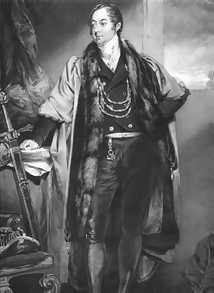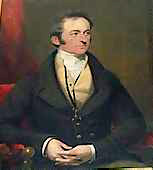Related Research Articles
Earl Fortescue is a title in the Peerage of Great Britain that was created in 1789 for Hugh Fortescue, 3rd Baron Fortescue (1753–1841), a member of parliament for Beaumaris and Lord-Lieutenant of Devon.

Earl of Harewood, in the County of York, is a title in the Peerage of the United Kingdom.

Viscount Ridley is a title in the Peerage of the United Kingdom. It was created in 1900 for the Conservative politician Sir Matthew White Ridley, 5th Baronet, Home Secretary from 1895 to 1900. He was made Baron Wensleydale, of Blagdon and Blyth in the County of Northumberland, at the same time, also in the Peerage of the United Kingdom. The latter title was a revival of the barony held by his maternal grandfather James Parke, Baron Wensleydale, whose title became extinct upon his death since none of his sons survived him.

Lawrence Dundas, 1st Earl of Zetland was a British politician and peer who sat in the House of Commons from 1790 to 1820 when he was raised to the peerage of the United Kingdom.

Sir George Nugent, 1st Baronet, GCB was a British Army officer. After serving as a junior officer in the American Revolutionary War, he fought with the Coldstream Guards under the Duke of York during the Flanders Campaign. He then commanded the Buckinghamshire Volunteers in the actions of St. Andria and Thuyl on the river Waal and participated in the disastrous retreat from the Rhine. He went on to be commander of the northern district of Ireland, in which post he played an important part in placating the people of Belfast during the Irish Rebellion, and then became Adjutant-General in Ireland. He went on to be Governor of Jamaica, commander of the Western District in England, commander of the Kent District in England and finally Commander-in-Chief, India.

Admiral Sir James Whitley Deans Dundas, GCB was a Royal Navy officer. He took part in the Napoleonic Wars, first as a junior officer when he took part in the Anglo-Russian invasion of Holland in Autumn 1799 and later as a commander when he was in action at Copenhagen Dockyard shortly after the capture of that City in August 1807. He also served as Whig Member of Parliament for Greenwich and then for Devizes and became First Naval Lord in the First Russell ministry in July 1847 and in that role his service was dominated by the needs of Whig party. He was appointed Commander-in-Chief in the Mediterranean in 1852 and led all naval operations in the Black Sea including the bombardment of Sevastopol in October 1854 during the Crimean War.

Richmond (Yorks) was a constituency in North Yorkshire in the House of Commons of the UK Parliament. It was represented from 1910 by members of the Conservative Party. The last MP for Richmond was Rishi Sunak, the former Prime Minister and Conservative leader from 2022 to 2024.

Ernest Augustus Charles Brudenell-Bruce, 3rd Marquess of Ailesbury,, styled Lord Ernest Brudenell-Bruce from 1821 until 1878, was a British courtier and politician. He served for many years as Vice-Chamberlain of the Household.
Sir Conyers Darcy or Darcey,, of Aske, near Richmond, Yorkshire, was a British Army officer, courtier and Whig politician who sat in the House of Commons between 1707 and 1758.

Albert Denison Denison, 1st Baron Londesborough, KCH, FRS, FSA, was a British Whig Party politician and diplomat, known as Lord Albert Conyngham from 1816 to 1849.
Thomas Steele PC was a British politician at the turn of the nineteenth century.

Admiral Maurice Frederick FitzHardinge Berkeley, 1st Baron FitzHardinge, was a Royal Navy officer. As a junior officer he commanded gunboats on the Tagus, reinforcing the Lines of Torres Vedras, in Autumn 1810 during the Peninsular War and, as a captain, he served on the coast of Syria taking part in the capture of Acre in November 1840 during the Oriental Crisis. He also served as Whig Member of Parliament for Gloucester and became First Naval Lord in the Aberdeen ministry in June 1854 and in that role focussed on manning the fleet and in carrying out reforms and improvements in the food, clothing, and pay of seamen.

Rear Admiral The Hon. George Heneage Lawrence Dundas CB was a senior officer in the Royal Navy. As a junior officer he came to prominence due to his brave conduct during a fire on the first-rate HMS Queen Charlotte. As a result of this he was appointed to the command of the sixth-rate HMS Calpe in which he took part in the Battle of Algeciras Bay in July 1801 during the French Revolutionary Wars. After serving for four years as Whig Member of Parliament for Richmond, he was given command of the fifth-rate HMS Euryalus and took part in the unsuccessful Walcheren Campaign in July 1809 during the Napoleonic Wars. He transferred to the third-rate HMS Edinburgh and landed troops at Viareggio in Italy in November 1812 later in that War. He went on to be Member of Parliament for Orkney and Shetland and became First Naval Lord in the First Melbourne ministry in August 1834 but died in office just two months later in October 1834.

Nicholas William Ridley-Colborne, 1st Baron Colborne was a British politician.
The Hon. John Charles Dundas was a British Whig, and later Liberal politician.

William Duncombe, 2nd Baron Feversham, was a British peer with a large estate in the North Riding of Yorkshire. He was prominent in the affairs of the Royal Agricultural Society and owner of a prize-winning herd of short-horn cattle. He served as a Tory Member of Parliament (MP) for the Riding from 1832 to 1841, after which he sat in the House of Lords, having succeeded to the title on the death of his father. From 1826 to 1831 he had sat as an Ultra-Tory MP. He was the first MP to support Richard Oastler's campaign for Factory Reform, and gave it unwavering support for the rest of his life; in 1847 he seconded the Second Reading in the Lords of the Factory Act of that year.

John Charles Ramsden was a British Whig politician from Newby Park in Yorkshire. He had a seat in the House of Commons between 1812 and 1836.
John Brampton Gurdon, known as Brampton Gurdon, was a British Liberal Party and Whig politician.
Hon. Charles Lawrence Dundas was a British politician and Whig Member of Parliament in the House of Commons. He represented Malton from 1798–1805 and Richmond from 1806 to his death.

Lieutenant-General Sir Robert Lawrence Dundas was a British Whig and military commander during the Peninsular War. He was a Member of Parliament in the House of Commons representing Malton from 1807 to 1812, East Retford from 1826 to 1827, and Richmond from 1828 to 1834 and from 1839 to 1841.
References
- 1 2 M. Stenton, ed. (1976). Who's Who of British Members of Parliament: Volume I 1832-1885. Harvester Press. p. 85.
- ↑ "Election movements - Richmond". London Evening Standard. 23 June 1841.
- ↑ "Representation of Richmond". Yorkshire Gazette. 3 July 1841.
- ↑ "The Richmond Election". Yorkshire Gazette. 16 March 1839.
- ↑ "Death of the Hon William N Ridley Colborne MP". Illustrated London News. 28 March 1846.